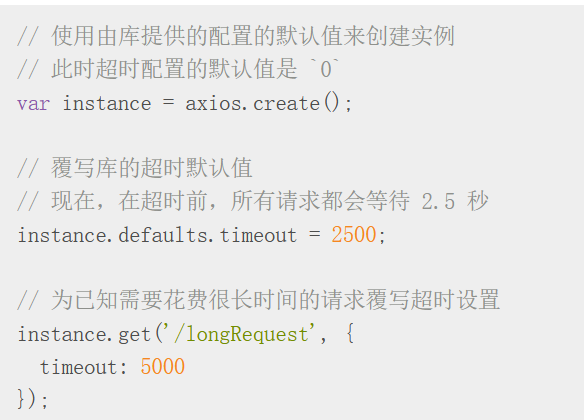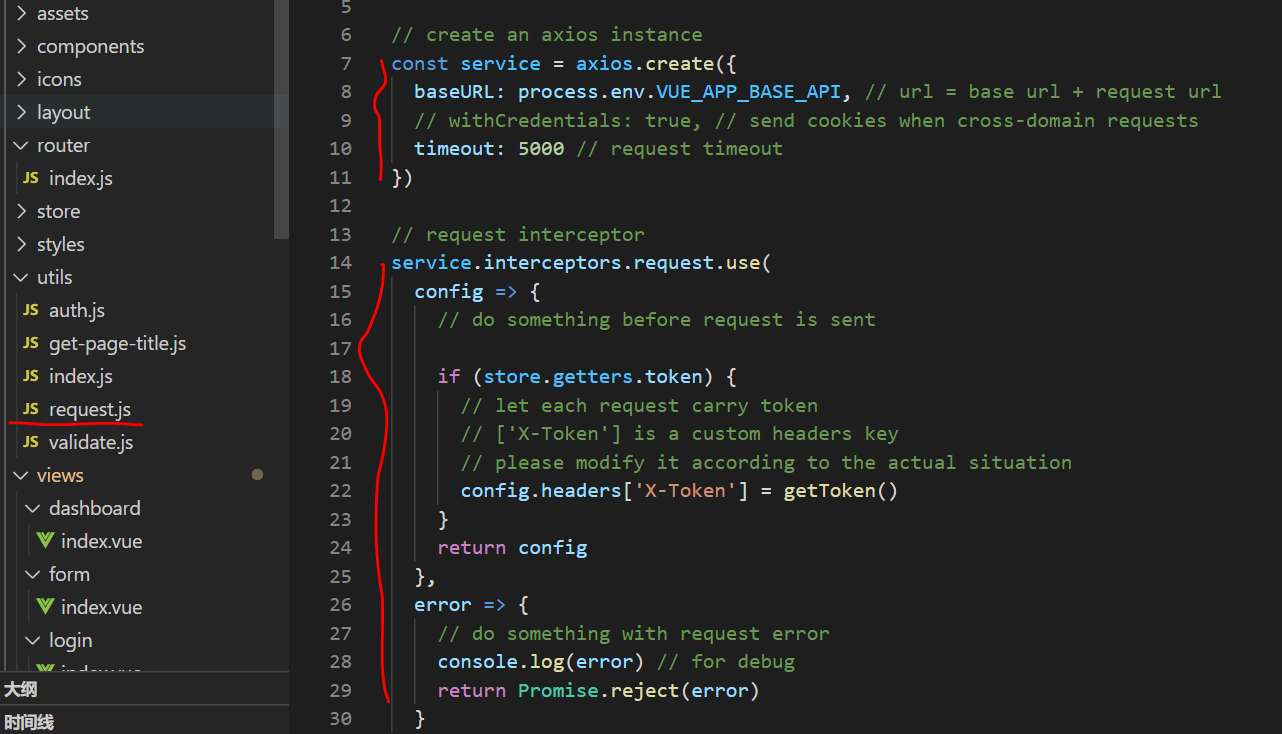axios简介
axios的npm文档:npm-axios
当然也有axios爱好者共建的中文网:http://www.axios-js.com/zh-cn/docs/
axios本质上也是对原生XHR的封装,只不过它是Promise的实现版本,符合最新的ES规范,会用ajax很容易上手axios

vue axios入门
- npm安装,就不复述了
npm install axios --save
- 引用
因为axios是一个库,不是vue中的第三方插件,不能直接通过Vue.use()安装插件
一般写在vue项目的mian.js中:
import Vue from 'vue'
import axios from 'axios'
- 简便配置
为了更方便的使用axios,可以在main.js中配置
// 全局注册:给Vue函数添加一个原型属性$axios 指向Axios
Vue.prototype.$axios = axios
// 请求地址为baseurl+url
axios.defaults.baseURL = 'http://localhost:8080'
第一条:后续可以通过this.$axios直接使用,不用重复引用axios
第二条:请求时的url是通过baseURL+url拼接,就不需要重复写ip+port了
- 简单的demo
getUser() {
const _this = this
this.$axios({
method: 'get',
url: '/admin/getById',
params : {
"id" : this.id
}
}).then(function(response) {
console.log(response.data)
_this.tableData = response.data
})
},
很明显,对应请求是:http://localhost:8080/admin/getById,后端写好对应的接口并返回数据就能接收到数据了
axios相关方法
方法
上面的方法就是基本的通过向 axios 传递相关配置来创建请求
axios也为所有支持的请求方法提供了别名
delete,head, options与get类似,put, patch与post类似
axios.get(url[, config]):get请求axios.post(url[, data[, config]]):post请求axios.request(config):实际上所有aixos请求的创建都是request方法来实现的axios.delete(url[, config]):delete请求axios.head(url[, config]):类似与get,只是不会获得响应内容,用于获取报头axios.options(url[, config]):options请求axios.put(url[, data[, config]]):put请求axios.patch(url[, data[, config]]):只将更改的数据推送到后端
处理并发请求的助手函数
axios.all([getUserAccount(), getUserPermissions()])
.then(axios.spread(function (acct, perms) {
// 两个请求现在都执行完成
}));
-
axios.all(iterable):Promise.all的封装,将多个请求并发执行
axios.all方法接受一个数组作为参数,数组中的每个元素都是一个请求,返回一个promise对象,当数组中所有请求均已完成时,执行then方法。 -
axios.spread(callback):接收一个函数作为参数,返回一个新的函数。接收的参数函数的参数是axios.all方法中每个请求返回的响应。
使用自定义配置新建一个 axios 实例
axios.create([config])
const instance = axios.create({
baseURL: 'http://localhost:8080',
timeout: 1000,
headers: {'X-Custom-Header': 'foobar'}
});
创建了instance实例,然后使用就可以了:
instance(
method : 'get',
url : "/admin/getById",
params : {
"id" : this.id
}
)
请求方法写法
- 最基本写法:axios(config)
method为get时可以省略
getUser() {
const _this = this
this.$axios({
method: 'get',
url: '/admin/getById',
params : {
"id" : this.id
}
}).then(function(response) {
console.log(response.data)
_this.tableData = response.data
})
},
- 使用对应的请求方法
getUser() {
const _this = this
this.$axios.get('/admin/getById', {
params : {
"id" : this.id
}
}).then(function(response) {
console.log(response.data)
_this.tableData = response.data
})
},
请求配置参数
config中不仅仅上面这些参数
{
// `url` 是用于请求的服务器 URL
url: '/user',
// `method` 是创建请求时使用的方法
method: 'get', // default
// `baseURL` 将自动加在 `url` 前面,除非 `url` 是一个绝对 URL。
// 它可以通过设置一个 `baseURL` 便于为 axios 实例的方法传递相对 URL
baseURL: 'https://some-domain.com/api/',
// `transformRequest` 允许在向服务器发送前,修改请求数据
// 只能用在 'PUT', 'POST' 和 'PATCH' 这几个请求方法
// 后面数组中的函数必须返回一个字符串,或 ArrayBuffer,或 Stream
transformRequest: [function (data, headers) {
// 对 data 进行任意转换处理
return data;
}],
// `transformResponse` 在传递给 then/catch 前,允许修改响应数据
transformResponse: [function (data) {
// 对 data 进行任意转换处理
return data;
}],
// `headers` 是即将被发送的自定义请求头
headers: {'X-Requested-With': 'XMLHttpRequest'},
// `params` 是即将与请求一起发送的 URL 参数
// 必须是一个无格式对象(plain object)或 URLSearchParams 对象
params: {
ID: 12345
},
// `paramsSerializer` 是一个负责 `params` 序列化的函数
// (e.g. https://www.npmjs.com/package/qs, http://api.jquery.com/jquery.param/)
paramsSerializer: function(params) {
return Qs.stringify(params, {arrayFormat: 'brackets'})
},
// `data` 是作为请求主体被发送的数据
// 只适用于这些请求方法 'PUT', 'POST', 和 'PATCH'
// 在没有设置 `transformRequest` 时,必须是以下类型之一:
// - string, plain object, ArrayBuffer, ArrayBufferView, URLSearchParams
// - 浏览器专属:FormData, File, Blob
// - Node 专属: Stream
data: {
firstName: 'Fred'
},
// `timeout` 指定请求超时的毫秒数(0 表示无超时时间)
// 如果请求话费了超过 `timeout` 的时间,请求将被中断
timeout: 1000,
// `withCredentials` 表示跨域请求时是否需要使用凭证
withCredentials: false, // default
// `adapter` 允许自定义处理请求,以使测试更轻松
// 返回一个 promise 并应用一个有效的响应 (查阅 [response docs](#response-api)).
adapter: function (config) {
/* ... */
},
// `auth` 表示应该使用 HTTP 基础验证,并提供凭据
// 这将设置一个 `Authorization` 头,覆写掉现有的任意使用 `headers` 设置的自定义 `Authorization`头
auth: {
username: 'janedoe',
password: 's00pers3cret'
},
// `responseType` 表示服务器响应的数据类型,可以是 'arraybuffer', 'blob', 'document', 'json', 'text', 'stream'
responseType: 'json', // default
// `responseEncoding` indicates encoding to use for decoding responses
// Note: Ignored for `responseType` of 'stream' or client-side requests
responseEncoding: 'utf8', // default
// `xsrfCookieName` 是用作 xsrf token 的值的cookie的名称
xsrfCookieName: 'XSRF-TOKEN', // default
// `xsrfHeaderName` is the name of the http header that carries the xsrf token value
xsrfHeaderName: 'X-XSRF-TOKEN', // default
// `onUploadProgress` 允许为上传处理进度事件
onUploadProgress: function (progressEvent) {
// Do whatever you want with the native progress event
},
// `onDownloadProgress` 允许为下载处理进度事件
onDownloadProgress: function (progressEvent) {
// 对原生进度事件的处理
},
// `maxContentLength` 定义允许的响应内容的最大尺寸
maxContentLength: 2000,
// `validateStatus` 定义对于给定的HTTP 响应状态码是 resolve 或 reject promise 。如果 `validateStatus` 返回 `true` (或者设置为 `null` 或 `undefined`),promise 将被 resolve; 否则,promise 将被 rejecte
validateStatus: function (status) {
return status >= 200 && status < 300; // default
},
// `maxRedirects` 定义在 node.js 中 follow 的最大重定向数目
// 如果设置为0,将不会 follow 任何重定向
maxRedirects: 5, // default
// `socketPath` defines a UNIX Socket to be used in node.js.
// e.g. '/var/run/docker.sock' to send requests to the docker daemon.
// Only either `socketPath` or `proxy` can be specified.
// If both are specified, `socketPath` is used.
socketPath: null, // default
// `httpAgent` 和 `httpsAgent` 分别在 node.js 中用于定义在执行 http 和 https 时使用的自定义代理。允许像这样配置选项:
// `keepAlive` 默认没有启用
httpAgent: new http.Agent({ keepAlive: true }),
httpsAgent: new https.Agent({ keepAlive: true }),
// 'proxy' 定义代理服务器的主机名称和端口
// `auth` 表示 HTTP 基础验证应当用于连接代理,并提供凭据
// 这将会设置一个 `Proxy-Authorization` 头,覆写掉已有的通过使用 `header` 设置的自定义 `Proxy-Authorization` 头。
proxy: {
host: '127.0.0.1',
port: 9000,
auth: {
username: 'mikeymike',
password: 'rapunz3l'
}
},
// `cancelToken` 指定用于取消请求的 cancel token
// (查看后面的 Cancellation 这节了解更多)
cancelToken: new CancelToken(function (cancel) {
})
}
其中:
get/delete/head/options请求带参数时,用params:添加到url的请求字符串中的;
post/put/patch带参数时,用data:添加到请求体(body)中
配置的优先顺序
请求方法中的config > 创建axios实例中的config > 库中的默认配置
以下超时时间:

优先级最高的是5000,然后是2500,最后是库提供的0
同样,baseURL在mian.js中全局配置,如果需要请求其他baseURL,只需在请求方法中设置
getUser() {
const _this = this
this.$axios.get('/admin/getById', {
baseURL : 'http://localhost:9090'
params : {
"id" : this.id
}
}).then(function(response) {
console.log(response.data)
_this.tableData = response.data
})
},
响应
response的结构:

{
// `data` 由服务器提供的响应
data: {},
// `status` 来自服务器响应的 HTTP 状态码
status: 200,
// `statusText` 来自服务器响应的 HTTP 状态信息
statusText: 'OK',
// `headers` 服务器响应的头
headers: {},
// `config` 是为请求提供的配置信息
config: {},
// 'request'
// `request` is the request that generated this response
// It is the last ClientRequest instance in node.js (in redirects)
// and an XMLHttpRequest instance the browser
request: {}
}
data才是后端传来的数据,所以通常是使用response.data
拦截器
axios都封装好了,直接使用:
- 请求拦截器
// 添加请求拦截器
axios.interceptors.request.use(
function (config) {
// 在发送请求之前做些什么
return config;
},
function (error) {
// 对请求错误做些什么
return Promise.reject(error);
});
- 响应拦截器
// 添加响应拦截器
axios.interceptors.response.use(
function (response) {
// 对响应数据做点什么
return response;
},
function (error) {
// 对响应错误做点什么
return Promise.reject(error);
});
- 移除拦截器
const myInterceptor = axios.interceptors.request.use(function () {/*...*/});
axios.interceptors.request.eject(myInterceptor);
注意:如果写在.vue文件中,就需要写在create方法中
而且一个界面创建了拦截器,所有界面都有


当然,vue项目是写在utils/request.js中

错误处理
上面的方法其实不完整,还缺少错误处理this.$axios.get().then().catch()
getUser() {
const _this = this
this.$axios.get('/admin/getById', {
params : {
"id" : this.id
}
}).then(function(response) {
console.log(response.data)
_this.tableData = response.data
}).catch(function(error) {
console.log(error)
})
},





















 1万+
1万+











 被折叠的 条评论
为什么被折叠?
被折叠的 条评论
为什么被折叠?








